Takeaways from our herbicide livestream
No one can make weeding fun like Dr. Janna Beckerman and Steve Larson. This dynamic duo from chemical company Envu delivered excellent advice about the cost of hand-weeding (or even worse, not weeding!), along with tips for applying pre-emergence herbicides like Envu’s Marengo, in the free livestream event I hosted last Wednesday. Such as:
- According to Dr. Hannah Mathers, who evaluated the cost-effectiveness of different pre-emergence herbicides, it costs about $160 per week per acre to hand-weed a nursery.
- Conversely, using pre-emergence herbicides costs $42 to $62 per acre per week.
- You can save 66% to 73% in overall weed control costs by using a pre-emergence herbicide program instead of depending solely on hand-weeding.
- Weeds harbor unwanted insects and diseases. “If you aren’t managing your weeds well, they will serve as a reservoir not just for diseases, but also for insect pests,” warned Dr. Beckerman.

- Start at the source—keeping weeds out of propagation areas and young plants will help keep them out of your production areas.
- It’s important to know your weeds and their germination periods so your applications will be effective. Some weeds germinate in the fall and winter, while others germinate in the fall and spring.
- Weeds CAN develop resistance to herbicides. For instance, marestail is showing resistance to glyphosate (Roundup) in many areas of the U.S.
For all the tips, tricks and details, register and watch the whole livestream HERE.

I didn’t attend Farwest, but I’ve got the scoop!
Publisher Paul Black was out in Portland a couple weeks ago for the Oregon Association of Nurserymen’s annual Farwest Show. He’s not a reporter, but he’s a good photographer; that’s his picture of the Best-in-Show booth down below. For the show deets, I rely on Curt Kipp, OAN’s director of publications and communications, who supplied me with all the event coverage.
Attendance was solid for this post-COVID period—4,000 attendees visiting 326 exhibitors—including 60 first-time exhibitors. All told, 46 states and 15 countries were represented.
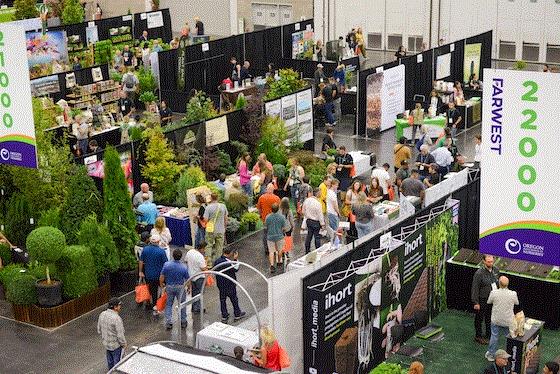
For industry veteran Joshua LaPoint, owner of Standard Nursery in Lafayette, Oregon, it was his first time representing his own nursery instead of someone else’s.
“Coming as an owner instead of working for someone else definitely gives you a different spin on things,” he said. “It’s been awesome—definitely a positive show for us. I got to meet a bunch of new customers and vendors as well. They’ve got big product and different material that I don’t have yet, but I want to bring to my customers.”
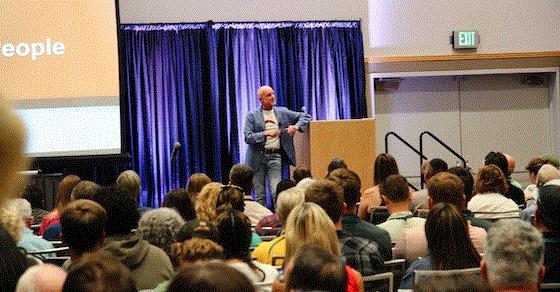 Keynote presenter John Kennedy spoke on “Plant Your People” by building a company culture where employees show up to work because they want to, not because they have to.
Keynote presenter John Kennedy spoke on “Plant Your People” by building a company culture where employees show up to work because they want to, not because they have to.

Popular plants
Seeing how Oregon (and the Pacific Northwest in general) is home to some of America’s top woody ornamental businesses, Farwest is a great place to seek out new tree and shrubs … and existing ones grown really well, for that matter!
Best in show, which I assume is the top prize among plants because it comes from professional judges, went to Fescue Glow Sticks. Discovered by Jeremy Schmidt and submitted to the show by Concept Plants, this cultivar of Festuca arundinacea is available from Briggs Nursery.

According to Concept Plants, “Glow Sticks Fescue dazzles from mid-spring with an incredible show of bright yellow flower spikelets that create a great contrast with the foliage. It’s unlike any ornamental grass you've ever seen. The dark green blades retain their color all year, making this ornamental stunning during the summer months and year-round.”
They say is grows to 24-in. tall and 36-in. wide, and performs well from Zones 3a to 9b. Briggs offers it as 72-cell plugs or pint, quart and #1 containers.
The judges also liked a few other entries, to which they gave Awards of Merit:
- Echibeckia Summerina Firana Black-Eyed Susan (hybridized by Bart Noordhuis and submitted by Pacific Plug & Liner)
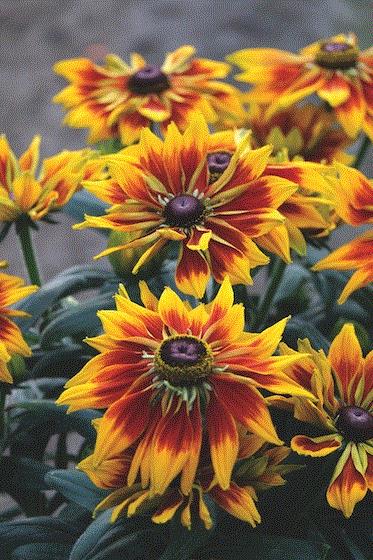
- Hydrangea paniculata Bubble Bath (Hybridized by Lendert de Vos and introduced by Bloomin’ Easy Plants)
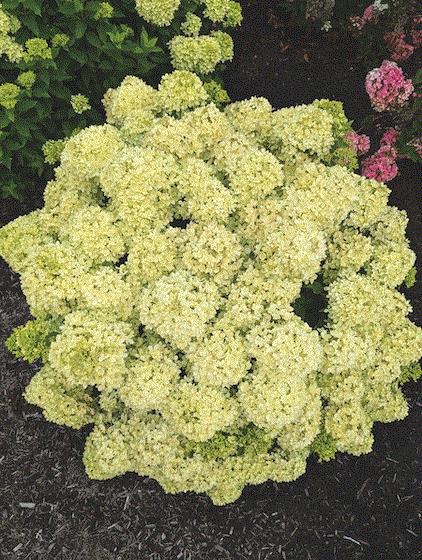
- Daphne Perfume Princess White (Bred by Mark Jury and Anthony Tesselaar, and submitted by Briggs Nursery)
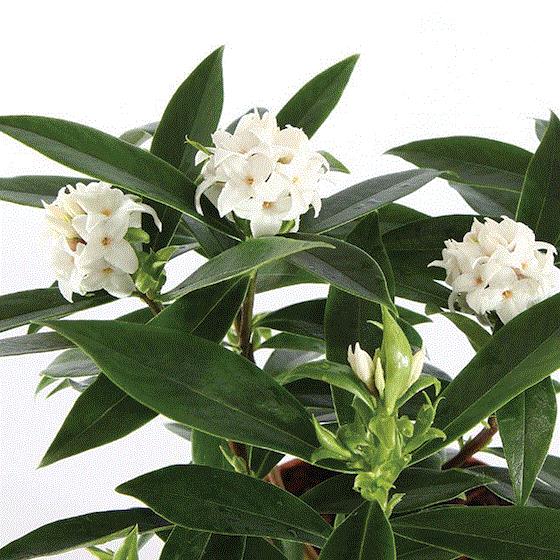

The people picked a maple
While the Best-in-Show is selected by “professional” judges, I give no less credit to the “people” who select the People’s Choice winner at Farwest … after all, most of those people are professionals, too. The people’s pick? Hybrid Maple Alpenglow, hybridized by Paul H. Halladin in Boring, Oregon, and introduced by Iseli Nursery.
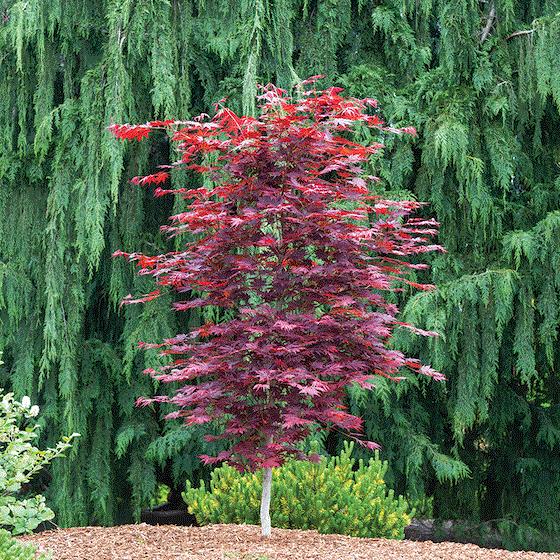
It’s a cross between A. palmatum (Japanese maple) and A. pseudosieboldianum (Korean maple), which is said to improve its cold tolerance down to Zone 4a (it will go south to Zone 8B).
According to Iseli, “Alpenglow is a red-leafed, upright hybrid maple that is hardy down to -30F. In spring, merlot leaves dance on arching branches; translucent veins help them catch the light and glow. The deep red mellows to a burnished bronze in summer and finally turns to blazing orange and red in fall. A refined oval habit and sturdy branching make this a majestic centerpiece that you can rely on for a colorful show year after year.”
The People’s Choice also includes three runner’s up (Awards of Merit):
- Ipomoea Sweet Caroline Medusa (Proven Winners)
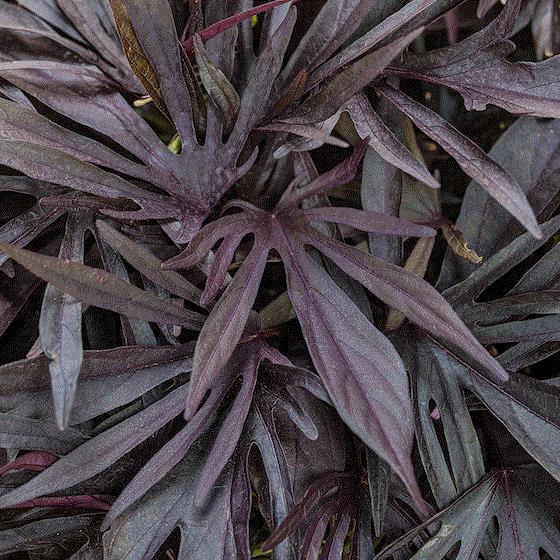
- Ipomoea Sweet Caroline Sweetheart Shadowstorm (Proven Winners)

- Hydrangea Seaside Serenade Pebble Beach (hybridized by Dr. Michael Dirr and introduced by Monrovia)
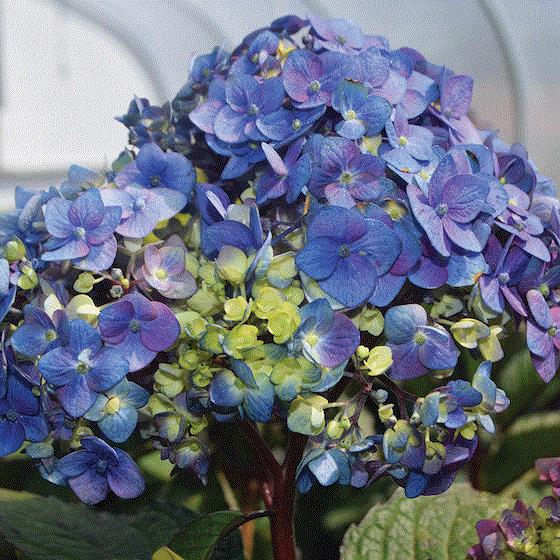

Youngblood named Best In Show exhibitor
We keep saying we need more young blood in this business. And maybe more Youngblood—as in the Salem, Oregon, nursery, which impressed the judges enough for them to name Youngblood Nursery the Best in Show booth award winner for 2025. They get more than a plaque or ribbon—the award comes with a free 10 x10 booth space for the 2026 Farwest Show.
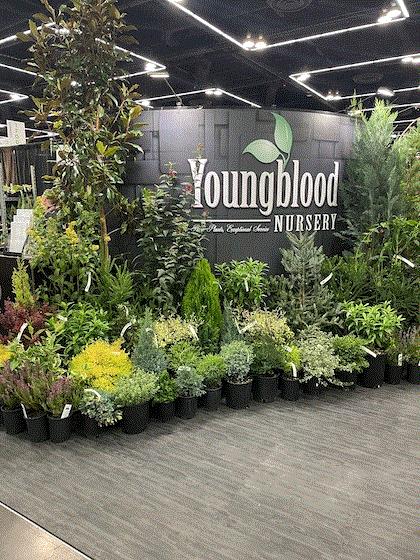
“There were some attention-getters this year,” said Farwest Chair Mikaela Eaton. “It seemed like everywhere you turned there was a booth that caught your eye.”
Buddy Lee on Encore Autumn Kiss
While we’re on the topic of woody plants, here’s a bit of insight about Autumn Kiss, the 37th variety in the Encore Azalea collection, from its breeder, the famous Buddy Lee of Hammond, Louisiana. (BTW, the folks from Garden Media Group did the interview, not me, but I found it intersting enough to share):
What was the development process for Autumn Kiss?
“I’ve been looking at this particular plant for about eight to 10 years. My process involves following a promising plant across generations, selecting from seedlings and ensuring that the traits I’m most excited about are stable. Finding a winner means striking the right balance; choosing traits that will catch consumers’ eyes on store shelves, demonstrate strong propagation and performance for growers and deliver the resilience landscape professionals rely on.”
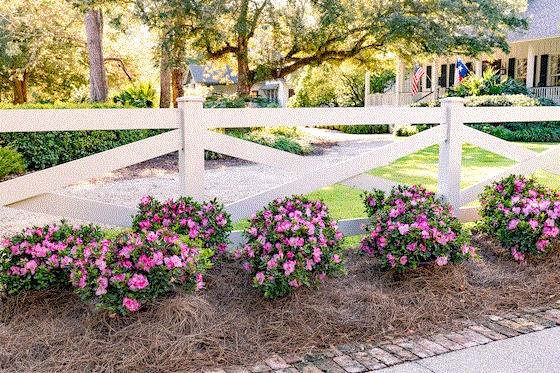
At what point did you recognize Autumn Kiss as a particularly promising variety?
“With Autumn Kiss, as with most of the plants I breed, it wasn’t love at the very first bloom. But as it matured, that first spring brought this incredible blast of color and it flowered so vigorously it almost looked as though it had been greenhouse-treated. My growers started sending me pictures saying, ‘Look at this!’ That’s when it clicked. And when the plants weathered an extremely cold winter without burnt stems, the variety earned its place.”
How would you describe the unusual bloom color on this variety?
“The blooms are 3 to 4 in. across and have a light pink to white center with a darker pink edge and a crepe-paper texture. In spring, the bloom hues are more intense; in late fall, they’re softer. The center petaloids are a solid, saturated pink, which is where the 'kiss' name comes from: they look like pink lips.”
What makes this variety appealing to retailers and landscapers?
“For retailers, the 'wow' factor of the blooms helps this variety stand apart on the rack and its compact size is what consumers are looking for right now. For landscaping professionals, it’s frankly a pretty tough little azalea. Autumn Kiss establishes itself well into garden soil or a raised bed, and it makes for a gorgeous container planting. It also doesn’t need much pruning to maintain, and it has excellent heat and environmental tolerances.”
Are there hidden strengths to this variety?
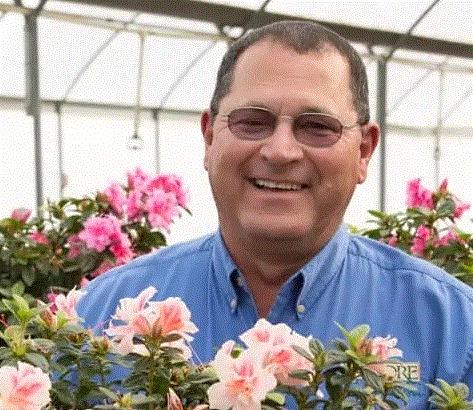
“Most people call it a dwarf, but I’d say it’s more of a mid-dwarf, topping out at 3 to 4 ft. Autumn Kiss has a strong, healthy root system, which allows for better pest tolerance, leaves that hold their glossy shine in full sun and resilience against environmental stressors. It doesn’t produce many long shoots and stays neat and mounding, making it a versatile, tidy little plant.”
What can we expect in the future from the Encore program?
“Looking ahead, I’m focusing on traits like leaf color and fragrance—projects I’ve been working on for years that are now showing promising results. As a plant breeder, sometimes your imagination runs ahead of reality, but that’s part of the fun. I’m exploring new leaf colors, different flower forms, more intricate color patterns in azaleas and even stronger plants overall. I have so many goals, but they all branch from the same start: the search for a beautiful plant that performs.”

NL: Prices soft and the season a 7.17?
I like to share international plant news when I find it. This is from Rabobank, as recently shared by a Dutch-based newsletter. Rabobank has published its “Horticulture Barometer,” which is an estimate by Rabobank regarding the question: “What rating do you give the financial development in horticulture?” Interestingly, they use a scale of 1 to 10—just like my weekly Spring Weekend Survey. The score for the current quarter? 7.17.
Here's their five-year chart, by quarter:
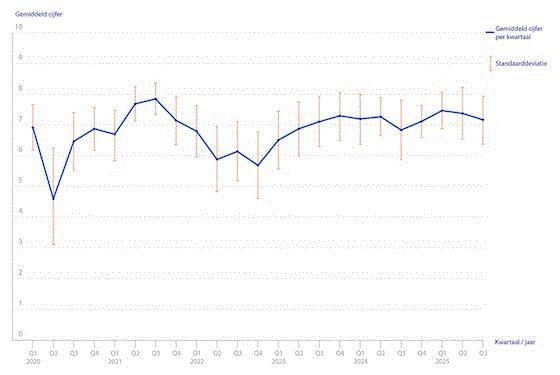
One difference between them and us: You think a 7 is okay, fair, so-so … like getting a C in a class (which is 70% or at least was back in my day).
But said Rabobank of that score, “Overall, the economic situation in horticulture is more than satisfactory. In Rabobank's horticulture barometer, the sector scored a 7.17 in the third quarter of this year on a scale from 0 to 10. Figure 1 shows how this indicator has developed over the past five years. For more than two years now, since the second quarter of 2023, the score has remained steady at or just above 7.”
Then Rabobank offered some stats to go along with the score:
- “Even in the current growing year (2025), prices for most horticultural products remain more than sufficient. … Prices for fruit vegetables (tomatoes, cucumbers, bell peppers) are not reaching the five-year average, but are sufficient to cover costs for most companies. However, this has certainly not yet led to a revival of greenhouse construction in the Netherlands.”
- “Average prices for tomatoes, peppers and cucumbers are lower than in 2024. On the bright side, growers are facing fewer virus outbreaks, since many tomato producers have switched to resistant varieties. Pepper growers, too, seem to have largely overcome root-related problems.”
- “Cut flower prices have stayed at a healthy level, although spring supply was somewhat lower than expected. This was mainly due to fewer tulips being available, as bulb stocks were tight. Potted plant prices and volumes remained fairly stable, though standard foliage plants are still being sold below production cost. According to Floridata, the total export value of cut flowers and potted plants in the first half of 2025 rose by around 2.7% compared to the same period last year.”
- “Tulip growers report a good harvest and pre-sales of bulbs look encouraging as well. Growing conditions for lilies have been excellent up to July 2025. Peonies also delivered a strong harvest, but results varied widely depending on sales strategy. Growers with fixed contracts were less affected by price pressure. Markets for daffodils and calla lilies, however, remain under some pressure.”
That’s good news about tulips, as three out of the last four bulb-growing seasons have been rough with accompanying shortages.

Rabobank (continued)
Rabobank continues their narrative:
For Dutch greenhouse construction companies, the global market is their playing field. … Even so, industry representatives and their trade association AVAG stress how crucial it is to keep new construction projects going in the Netherlands itself. … For now, however, a real upswing in the domestic market is not on the horizon. Rabobank points to CBS data on orders, order backlogs and completed projects, which all suggest that activity in Dutch greenhouse construction remains at a low level.
They conclude with:
“Continue investing in the future of horticulture. This is the time to look ahead and invest in sustainable cultivation and modern infrastructure. The market offers opportunities! Review your cultivation plan or business adjustments with your account manager to assess the opportunities for your business. Our sector managers are also always open to discussions.”
In other words, hit them up for a loan!

More NL news: Trade Fair Aalsmeer is coming up
Trade Fair Aalsmeer should be on everyone’s bucket list. It’s near Amsterdam, it’s in the late fall when travel is cheaper, it’s timed with another worthwhile show (the International Floriculture Trade Fair), and it’s simply the coolest flower and plant show ever, held in the coolest venue—the big Dutch auction known as Royal FloraHolland. What’s not to love?!
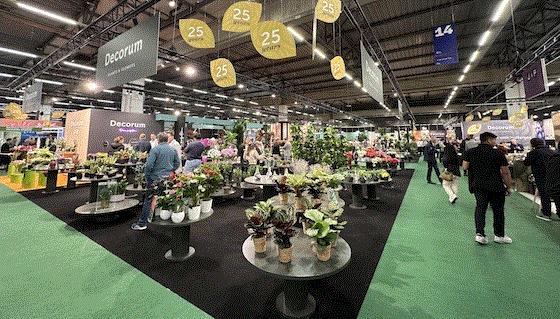
It will be November 4-6 in Aalsmeer, which is just minutes away from Amsterdam, so you can stay there or stay in Aalsmeer or Hoofddorp and plan a day trip into the city. The show itself features hundreds of Dutch growers along with the big breeders and distributors, so you see an amazing cross section of finished products—it’s great for packaging ideas! And best of all, you can see the auction in action (a must for anyone in this industry) and you can visit Waterdrinker, a giant wholesaler located inside Royal FloraHolland, which displays nearly every horticultural product produced in Europe—your mind will be blown!
HERE is where you can learn more about the annual event—which is celebrating 25 years in 2025! One addition to this year’s event: a Tree Nursery Pavilion, showcasing 40 woody ornamental growers with trees, but also other outdoor landscape and garden plants.

Bailey honors five brand licensees … including one of our own!
When I say one of our own, I mean a Ball Publishing contributor—Art Parkerson, owner of Lancaster Farms in Virginia, one of our Growers Talk Business columnists and the writer of Plantpop on the Green Profit side. And really, I don’t mean Art, I mean his people, especially buyer Christopher Brown and grower Joe Compton, whose hard work led Lancaster Farms to be named Trial Grower of the Year out of all the Bailey brand licensee partners.
When the news came across my desk, I emailed Art to congratulate him and to find out why he thought his company had earned the award. Replied Art:
“Not sure, honestly. I’d chalk it up to our buyer and our grower. We’re very honest and candid with feedback … and we just might be the best shrub growers around!”
Trial Grower of the Year was one of five awards presented by Bailey:
- Endless Summer Grower of the Year – R.A. Dudley Nurseries
- First Editions Grower of the Year – Kraemer’s Nursery
- Easy Elegance Grower of the Year – Bracy’s Nursery
- New Variety Leader of the Year – Dewar’s Nurseries
“These awards are a meaningful way to celebrate the hard work and commitment our partners invest every day to bring these high-quality branded plants to market,” said Layci Gragnani, Brand & Business Development Manager at Bailey.

Multi-Year Perennial and Shrub Trials added to conference
Speaking of trials, the 2025 International Plant Trialing Conference, slated for October 13-15 in Bloomington, Minnesota, continues to evolve based on interest and demand. They've added a session for Multi-Year Perennial and Shrub Trials.
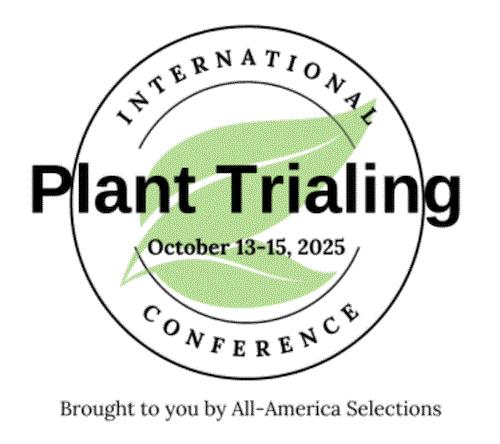
The in-depth three-hour session will feature Laura Robles from Walters Gardens, QiuXia Chen from Dümmen Orange, Rick Grazzini from Garden Genetics, Richard Hawke from Chicago Botanic Garden, Jonah Brown from Danziger and Michele Scheiber from Star Roses & Plants. They’ll talk about the diverse approaches, common hurdles and surprising similarities found across their own multi-year programs.
And speaking of Bailey, their trials will be open to attendees, as will the University of Minnesota’s and possibly others.
In case you missed the news when it launched, The International Plant Trialing Conference got its beginnings in 2011 in the UK, followed up in 2013 with an event at Longwood Gardens. The last event was held in 2015 in conjunction with the Farwest show in Portland, Oregon. That’s a decade ago—too long for those who want to learn how to best conduction plant trials—and so All-America Selections stepped up to host what I guess will be the fourth International Plant Trialing Conference.
Who’s it for? Plant trialers of all experience levels, who trial nearly any sort of ornamental or edible plants and want to gain valuable perspectives and knowledge from experts, and are looking to network with industry professionals from around the globe.
Learn more and sign up HERE.

Finally …
What do you say when an interviewer asks, “Do you have any questions?”
This is for those of you looking for jobs and going on interviews. It’s a tip I picked up online and I thought it a good one, worth trying. It’s what to say when an interviewer asks that famous last question: “Do you have any questions?”
I hope you never answer “nope!” That shows a lack of curiosity and enthusiasm about the company and the position. And don’t scramble to make something up because that's always obvious. Be prepared with three or four different questions. And if those were answered during the interview, pick one and say, “Tell me more about such and such.”
But here’s a real good question to try:
“Let’s say this interview went really well and I get the job and it’s a year from now. What will I have had to do over the past year for you to feel you made a good decision?”
Why is this a good question? First, it makes them imagine the interview going well. Second, they'll then lay out for you exactly what you need to do in the role to excel. That could lead to more questions about specifics of the job. And if you do get hired, it sets you up for success because you know the expectations.



Feel free to email me at beytes@growertalks.com if you have ideas, comments or questions.
See you next time!

Chris Beytes
Editor-in-Chief
GrowerTalks and Green Profit
This e-mail received by 29,752 loyal readers!
Thanks to my loyal sponsors, who help me reach the 29,752 readers of Acres Online in more than 60 countries. Want to be one of them (a sponsor, that is)? Give Kim Brown a shout and she will tell you about our many advertising opportunities.